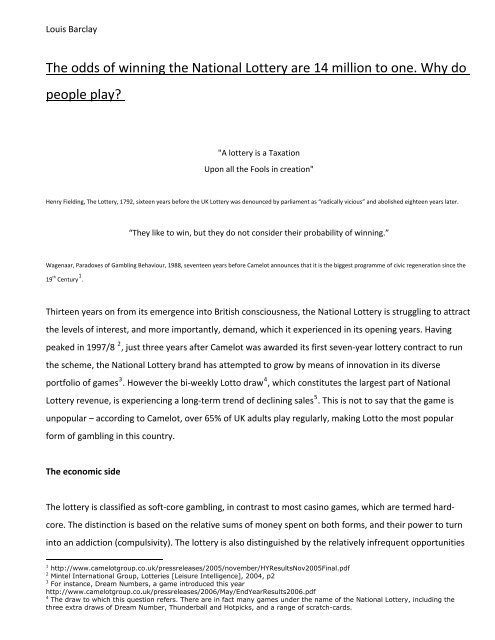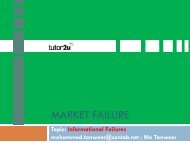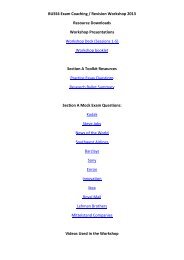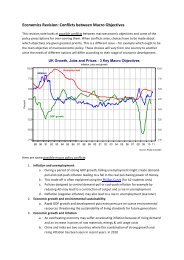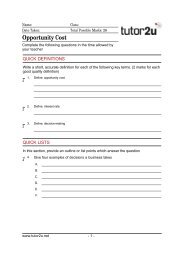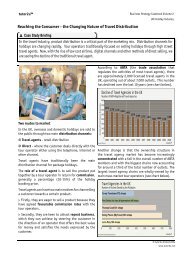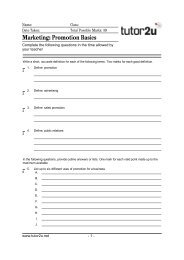The odds of winning the National Lottery are 14 million to ... - Tutor2u
The odds of winning the National Lottery are 14 million to ... - Tutor2u
The odds of winning the National Lottery are 14 million to ... - Tutor2u
Create successful ePaper yourself
Turn your PDF publications into a flip-book with our unique Google optimized e-Paper software.
Louis Barclay<br />
<strong>The</strong> <strong>odds</strong> <strong>of</strong> <strong>winning</strong> <strong>the</strong> <strong>National</strong> <strong>Lottery</strong> <strong>are</strong> <strong>14</strong> <strong>million</strong> <strong>to</strong> one. Why do<br />
people play?<br />
"A lottery is a Taxation<br />
Upon all <strong>the</strong> Fools in creation"<br />
Henry Fielding, <strong>The</strong> <strong>Lottery</strong>, 1792, sixteen years before <strong>the</strong> UK <strong>Lottery</strong> was denounced by parliament as “radically vicious” and abolished eighteen years later.<br />
“<strong>The</strong>y like <strong>to</strong> win, but <strong>the</strong>y do not consider <strong>the</strong>ir probability <strong>of</strong> <strong>winning</strong>.”<br />
Wagenaar, Paradoxes <strong>of</strong> Gambling Behaviour, 1988, seventeen years before Camelot announces that it is <strong>the</strong> biggest programme <strong>of</strong> civic regeneration since <strong>the</strong><br />
19 th Century 1 .<br />
Thirteen years on from its emergence in<strong>to</strong> British consciousness, <strong>the</strong> <strong>National</strong> <strong>Lottery</strong> is struggling <strong>to</strong> attract<br />
<strong>the</strong> levels <strong>of</strong> interest, and more importantly, demand, which it experienced in its opening years. Having<br />
peaked in 1997/8 2 , just three years after Camelot was awarded its first seven‐year lottery contract <strong>to</strong> run<br />
<strong>the</strong> scheme, <strong>the</strong> <strong>National</strong> <strong>Lottery</strong> brand has attempted <strong>to</strong> grow by means <strong>of</strong> innovation in its diverse<br />
portfolio <strong>of</strong> games 3 . However <strong>the</strong> bi‐weekly Lot<strong>to</strong> draw 4 , which constitutes <strong>the</strong> largest part <strong>of</strong> <strong>National</strong><br />
<strong>Lottery</strong> revenue, is experiencing a long‐term trend <strong>of</strong> declining sales 5 . This is not <strong>to</strong> say that <strong>the</strong> game is<br />
unpopular – according <strong>to</strong> Camelot, over 65% <strong>of</strong> UK adults play regularly, making Lot<strong>to</strong> <strong>the</strong> most popular<br />
form <strong>of</strong> gambling in this country.<br />
<strong>The</strong> economic side<br />
<strong>The</strong> lottery is classified as s<strong>of</strong>t‐core gambling, in contrast <strong>to</strong> most casino games, which <strong>are</strong> termed hard‐<br />
core. <strong>The</strong> distinction is based on <strong>the</strong> relative sums <strong>of</strong> money spent on both forms, and <strong>the</strong>ir power <strong>to</strong> turn<br />
in<strong>to</strong> an addiction (compulsivity). <strong>The</strong> lottery is also distinguished by <strong>the</strong> relatively infrequent opportunities<br />
1 http://www.camelotgroup.co.uk/pressreleases/2005/november/HYResultsNov2005Final.pdf<br />
2 Mintel International Group, Lotteries [Leisure Intelligence], 2004, p2<br />
3 For instance, Dream Numbers, a game introduced this year<br />
http://www.camelotgroup.co.uk/pressreleases/2006/May/EndYearResults2006.pdf<br />
4 <strong>The</strong> draw <strong>to</strong> which this question refers. <strong>The</strong>re <strong>are</strong> in fact many games under <strong>the</strong> name <strong>of</strong> <strong>the</strong> <strong>National</strong> <strong>Lottery</strong>, including <strong>the</strong><br />
three extra draws <strong>of</strong> Dream Number, Thunderball and Hotpicks, and a range <strong>of</strong> scratch-cards.
<strong>to</strong> play, and <strong>the</strong> relatively long delay between bet and outcome. Also, <strong>the</strong> payouts <strong>are</strong> organized so that<br />
<strong>the</strong>re is one disproportionately large prize, with several smaller, more attainable, rewards. While <strong>the</strong> <strong>odds</strong><br />
on <strong>winning</strong> <strong>the</strong> Lot<strong>to</strong> jackpot <strong>are</strong> 13,983,815 <strong>to</strong> one, <strong>the</strong>re is a 51 <strong>to</strong> one chance <strong>of</strong> <strong>winning</strong> any <strong>of</strong> <strong>the</strong><br />
prizes. Lastly, <strong>the</strong> simplicity <strong>of</strong> a lottery is noteworthy – in <strong>the</strong> case <strong>of</strong> Lot<strong>to</strong>, choosing six numbers from 1 <strong>to</strong><br />
49.<br />
<strong>The</strong> approach used within standard economics <strong>to</strong> evaluate decisions made in <strong>the</strong> face <strong>of</strong> risk and<br />
uncertainty is <strong>the</strong> expected value model 6 . In <strong>the</strong> context <strong>of</strong> a lottery, <strong>the</strong> model is used <strong>to</strong> comp<strong>are</strong> <strong>the</strong><br />
price <strong>of</strong> <strong>the</strong> ticket <strong>to</strong> <strong>the</strong> amount <strong>the</strong> lottery player could expect <strong>to</strong> take as a yield. This last part is calculated<br />
as <strong>the</strong> average value <strong>of</strong> <strong>the</strong> payout multiplied by <strong>the</strong> probability <strong>of</strong> one ticket <strong>winning</strong>. Typically for lotteries,<br />
<strong>the</strong> expected value is negative, and tends <strong>to</strong> range from about ‐30% <strong>of</strong> <strong>the</strong> ticket price <strong>to</strong> ‐70% or more. This<br />
is curious, as most hard‐core gambling features a higher expected value. Roulette, for example, has an<br />
7<br />
expected value <strong>of</strong> ‐5% . In <strong>the</strong> specific case <strong>of</strong> <strong>the</strong> UK lottery, <strong>the</strong> Lot<strong>to</strong>, on a £1 ticket <strong>the</strong> expected value is<br />
about 71 pence. In o<strong>the</strong>r words, <strong>the</strong> value from playing <strong>the</strong> <strong>Lottery</strong> is 29% less than <strong>the</strong> ticket price.<br />
<strong>The</strong>refore, <strong>the</strong> expected value model predicts that people will not play Lot<strong>to</strong>.<br />
In practice, people do play <strong>the</strong> lottery and this suggests that <strong>the</strong> expected value model ignores o<strong>the</strong>r<br />
utilities that <strong>are</strong> gained from a £1 lottery ticket, in addition <strong>to</strong> <strong>the</strong> 71 pence in expected value. <strong>The</strong>se utilities<br />
include, firstly, <strong>the</strong> opportunity <strong>to</strong> take part in an aspect <strong>of</strong> popular culture – banter with friends and family,<br />
and speculation over numbers and near misses. Secondly, <strong>the</strong>re is <strong>the</strong> ‘warm glow’ effect <strong>of</strong> having<br />
indirectly donated money <strong>to</strong> charity (29 pence per ticket). Finally, in <strong>the</strong> small scrap <strong>of</strong> paper <strong>the</strong>re is <strong>the</strong><br />
possibility <strong>of</strong> <strong>winning</strong> a life‐transforming sum <strong>of</strong> money. Referred <strong>to</strong> as ‘buying a dream’ this fac<strong>to</strong>r is<br />
considered by many <strong>to</strong> constitute <strong>the</strong> largest utility from playing <strong>the</strong> <strong>Lottery</strong>.<br />
<strong>The</strong> insufficiency <strong>of</strong> <strong>the</strong> conventional economic approach<br />
Do ticket‐buyers weigh up <strong>the</strong>se utilities and consider <strong>the</strong>m <strong>to</strong> more than make up for <strong>the</strong> 29 pence gap?<br />
Perhaps subconsciously, but <strong>the</strong>re is also a <strong>the</strong>ory that many <strong>of</strong> those who spend on lottery tickets suffer<br />
from psychological misconceptions which mean that in fact, <strong>the</strong>y do not consider <strong>the</strong> <strong>Lottery</strong> in rational<br />
terms. This is evidenced by <strong>the</strong> case <strong>of</strong> <strong>the</strong> competing Dutch lotteries in <strong>the</strong> 1980s: <strong>the</strong> State <strong>Lottery</strong> and <strong>the</strong><br />
Giro <strong>Lottery</strong>. <strong>The</strong> former had an expected value <strong>of</strong> ‐30%, with 2 <strong>million</strong> players. <strong>The</strong> Giro <strong>Lottery</strong> was<br />
5<br />
Lotteries [Leisure Intelligence], 2004, p2<br />
6<br />
As used in Willem Wagenaar’s Paradoxes <strong>of</strong> Gambling Behavior, 1988, and Stephen Creigh-Tyte and Lisa Farrell’s 1998 paper<br />
<strong>The</strong> Economics <strong>of</strong> <strong>the</strong> <strong>National</strong> <strong>Lottery</strong><br />
7<br />
According <strong>to</strong> <strong>The</strong> Times, in ‘<strong>The</strong> <strong>Lottery</strong> – It Shouldn’t Be You’, January 27, 2006, “Casinos typically pay out more than 97 per
launched with an expected value <strong>of</strong> ‐75% and <strong>the</strong>refore no rational player should have preferred <strong>to</strong> play it<br />
ra<strong>the</strong>r than <strong>the</strong> State lottery. None<strong>the</strong>less, it was able <strong>to</strong> attract 1.2 <strong>million</strong> players. This suggests that as<br />
long as a lottery keeps <strong>to</strong> “tacitly accepted properties <strong>of</strong> a fair structure” 8 , such as <strong>the</strong> low cost <strong>of</strong> a ticket,<br />
and sufficiently life‐transforming power <strong>of</strong> <strong>the</strong> main prize, it will attract demand.<br />
More evidence <strong>to</strong> suggest that, in general, Lot<strong>to</strong> players do not think rationally, lies in <strong>the</strong> price elasticity <strong>of</strong><br />
demand for Lot<strong>to</strong> tickets, which has been shown <strong>to</strong> lie close <strong>to</strong> unity 9 . This means that a 50% decrease in<br />
<strong>the</strong> price <strong>of</strong> a <strong>Lottery</strong> ticket will result in roughly a 50% increase in <strong>the</strong> quantity demanded. However, <strong>the</strong><br />
expected elasticity for rational consumers would lead <strong>to</strong> significantly, and disproportionately greater<br />
demand as <strong>the</strong> price ne<strong>are</strong>d <strong>the</strong> expected value <strong>of</strong> <strong>the</strong> <strong>Lottery</strong> ticket and went below it. This is because <strong>the</strong><br />
money spent on a ticket priced at its expected value (or less) would effectively be a worthwhile investment.<br />
Heuristics and biases<br />
<strong>The</strong> psychological misconceptions that might make players more likely <strong>to</strong> buy a lottery ticket can be divided<br />
in<strong>to</strong> two categories: intuitive discovery processes, named ‘heuristics’, and partialities which hinder<br />
objective consideration <strong>of</strong> an issue, correctly termed ‘biases’ 10 . Willem Wagenaar calls <strong>the</strong>se a “bag <strong>of</strong><br />
tricks” 11 which, <strong>to</strong>ge<strong>the</strong>r, may go some way <strong>to</strong> explaining <strong>the</strong> mind set <strong>of</strong> lottery participants, and in<br />
particular <strong>the</strong> failure <strong>of</strong> feedback – that is, why continued losses do not disillusion players.<br />
<strong>The</strong>re <strong>are</strong> two main biases:<br />
Confirmation bias happens when a person neglects <strong>the</strong> principle <strong>of</strong> regression <strong>to</strong> <strong>the</strong> mean. This is <strong>to</strong> say<br />
that a person might think that <strong>the</strong>y <strong>are</strong> on a <strong>winning</strong> streak, or ‘getting closer’, because <strong>the</strong>y have had two<br />
near misses with <strong>the</strong>ir numbers. Some players believe that certain numbers have a higher likelihood <strong>of</strong><br />
<strong>winning</strong>, as evidenced by sites such as lotterygen.co.uk which present statistics <strong>of</strong> ‘hot’ numbers.<br />
Hindsight bias occurs from thinking that a loss was predicted – in o<strong>the</strong>r words, that not <strong>winning</strong> was<br />
inevitable. This encourages <strong>the</strong> person <strong>to</strong> think that <strong>the</strong>y will win on <strong>the</strong> next gamble, because <strong>the</strong>y believe<br />
that <strong>the</strong>ir predictions hold fast.<br />
cent <strong>of</strong> money staked”<br />
8<br />
Paradoxes <strong>of</strong> Gambling Behavior p70<br />
9<br />
Farrell et al., 1996<br />
10<br />
Hogarth, 1981
Five heuristic explanations <strong>are</strong> identified:<br />
Problem framing is when a player attributes losing <strong>to</strong> a lack <strong>of</strong> skill, possibly subconsciously. <strong>The</strong>refore in<br />
<strong>the</strong> case <strong>of</strong> <strong>the</strong> lottery, every new selection <strong>of</strong> numbers is a new attempt <strong>to</strong> refine technique. Buying tickets<br />
regularly is important for <strong>the</strong> process <strong>of</strong> improving.<br />
Similarly, flexible attribution results from players considering skill <strong>to</strong> have had a hand in a near miss, but<br />
losing <strong>to</strong> be down <strong>to</strong> o<strong>the</strong>r fac<strong>to</strong>rs such as buying <strong>the</strong> ticket from <strong>the</strong> wrong place, or at <strong>the</strong> wrong time.<br />
<strong>Lottery</strong> companies along with <strong>the</strong> media publicize <strong>the</strong> winners <strong>of</strong> <strong>the</strong> jackpot. This leads people <strong>to</strong> consider<br />
a higher ‘availability’ <strong>of</strong> <strong>the</strong> prize than that which actually exists. It <strong>the</strong>refore causes <strong>the</strong>m <strong>to</strong> overestimate<br />
<strong>the</strong> probability and consider <strong>the</strong> lottery more worthwhile. Camelot, <strong>the</strong> owners <strong>of</strong> <strong>the</strong> <strong>National</strong> <strong>Lottery</strong><br />
contract, have emphasized availability in past advertising campaigns with slogans such as ‘it could be you’.<br />
Anticipa<strong>to</strong>ry regret applies <strong>to</strong> hard‐core players who keep <strong>the</strong> same numbers for every game <strong>the</strong>y play.<br />
<strong>The</strong>y feel compelled <strong>to</strong> buy tickets every Wednesday and Saturday for fear that on <strong>the</strong> day <strong>the</strong>y do not play,<br />
<strong>the</strong> numbers will come up.<br />
Illusory correlation is <strong>the</strong> belief in luck affecting <strong>the</strong> chance <strong>of</strong> success in a game. For instance, superstitious<br />
people who believe in lucky days might consider <strong>the</strong>ir <strong>odds</strong> improved, and thus be more likely <strong>to</strong> buy a<br />
ticket. This is similar <strong>to</strong> <strong>the</strong> gambler’s fallacy <strong>of</strong> failing <strong>to</strong> understand that success in <strong>the</strong> lottery is<br />
independent <strong>of</strong> success in o<strong>the</strong>r events.<br />
<strong>The</strong>se mental quirks <strong>are</strong> all made more likely by ano<strong>the</strong>r heuristic: ‘reduction <strong>of</strong> complexity’ 12 . This occurs<br />
when lottery players fail <strong>to</strong> realize what really determines <strong>the</strong> <strong>odds</strong> <strong>of</strong> <strong>winning</strong> <strong>the</strong> jackpot, and do not<br />
consider <strong>the</strong> scale <strong>of</strong> <strong>the</strong> game in correct proportion. But even <strong>the</strong>se psychological misconceptions do not<br />
satisfac<strong>to</strong>rily account for regular lottery play. <strong>The</strong>y may explain why people buy impulsively, such as in <strong>the</strong><br />
case <strong>of</strong> availability or illusory correlation, and may show some characteristics <strong>of</strong> hard‐core players, as in <strong>the</strong><br />
case <strong>of</strong> flexible attribution and problem framing, but <strong>the</strong>y do not account for <strong>the</strong> constant demand for<br />
lottery tickets by 27 <strong>million</strong> adults in <strong>the</strong> UK.<br />
Many critics and certain newspapers claim that <strong>the</strong> <strong>National</strong> <strong>Lottery</strong> encourages gambling among those<br />
11 Paradoxes <strong>of</strong> Gambling Behavior p76<br />
12 Paradoxes <strong>of</strong> Gambling Behavior p81
who can least afford it 13 . It is sometimes suggested that heuristics and biases <strong>are</strong>, by <strong>the</strong>ir nature, a feature<br />
<strong>of</strong> lower‐income groups, which <strong>are</strong> more poorly educated. <strong>The</strong>refore if heuristics and biases constituted a<br />
large part <strong>of</strong> <strong>the</strong> reasons for which people play <strong>the</strong> lottery regularly, some correlation between income and<br />
regular lottery play would be observed. A BRMB/Mintel study <strong>of</strong> 964 adults gives <strong>the</strong> following data on <strong>the</strong><br />
proportion <strong>of</strong> people in <strong>the</strong> five standard socio‐economic groups who play <strong>National</strong> <strong>Lottery</strong> games regularly:<br />
Saturday Wednesday<br />
AB 61% 34%<br />
C1 62% 33%<br />
C2 73% 38%<br />
D 64% 40%<br />
E 52% 33%<br />
From ‘Participation in NL games over <strong>the</strong> past 12 months, by gender, age, and socio‐economic group, May<br />
2004’ (Mintel International Group, Lotteries [Leisure Intelligence], 2004, p32).<br />
<strong>The</strong>se data question <strong>the</strong> view that lower socio‐economic groups play <strong>the</strong> lottery more. <strong>The</strong> middling<br />
C2 group is most dedicated <strong>to</strong> <strong>the</strong> <strong>National</strong> <strong>Lottery</strong>, but o<strong>the</strong>rs do not lag far behind. An explanation is<br />
needed <strong>to</strong> account for <strong>the</strong> fact that 61% <strong>of</strong> <strong>the</strong> (relatively well‐educated) AB demographic play <strong>the</strong><br />
Saturday Lot<strong>to</strong> on a regular basis.<br />
Prospect <strong>The</strong>ory<br />
Perhaps, <strong>the</strong>n, we must return <strong>to</strong> seek an explanation for why people playing <strong>the</strong> lottery may actually be<br />
behaving rationally. <strong>The</strong> heuristics and biases described above suggest that <strong>the</strong> human mindset when<br />
buying lottery tickets is significantly more liable <strong>to</strong> inconsistencies than in general, that is, <strong>the</strong>y seek <strong>to</strong><br />
explain lottery playing behaviour as a deviation from rationality. Normative <strong>the</strong>ories <strong>of</strong> gambling, accounts<br />
which attempt <strong>to</strong> explain lottery gambling “without essentially changing <strong>the</strong> nature <strong>of</strong> <strong>the</strong> game” <strong>14</strong> use <strong>the</strong><br />
rational mind as <strong>the</strong> point <strong>of</strong> reference. Prospect <strong>The</strong>ory (Kahneman and Tversky 1979) is <strong>the</strong> key normative<br />
<strong>the</strong>ory that can be applied <strong>to</strong> lottery play.<br />
To explain Prospect <strong>The</strong>ory, it is necessary <strong>to</strong> consider <strong>the</strong> condition under which lottery play is<br />
13<br />
<strong>The</strong> Times puts forward such views in ‘<strong>The</strong> <strong>Lottery</strong> – It Shouldn’t Be You’, January 27, 2006.<br />
<strong>14</strong><br />
Paradoxes <strong>of</strong> Gambling Behavior p71
economically rational (discarding <strong>the</strong> value <strong>of</strong> utilities such as those described above). This condition comes<br />
in <strong>the</strong> form <strong>of</strong> <strong>the</strong> following inequality:<br />
Expected value ≥ C<br />
<strong>The</strong> constant C represents <strong>the</strong> price <strong>of</strong> a ticket. <strong>The</strong> inequality is not flexible, but Prospect <strong>The</strong>ory suggests<br />
that <strong>the</strong> actual value <strong>of</strong> C <strong>to</strong> a person is. <strong>The</strong> price <strong>of</strong> a ticket is considered with reference <strong>to</strong> a person’s<br />
financial status quo; Hence, if <strong>the</strong> person is comfortable enough that <strong>the</strong> amount <strong>the</strong>y spend on <strong>the</strong> lottery<br />
every week is irrelevant <strong>to</strong> <strong>the</strong>m, C can be discarded (replaced by a value <strong>of</strong> 0), satisfying <strong>the</strong> inequality and<br />
making lottery play notionally rational.<br />
Prospect <strong>The</strong>ory questions <strong>the</strong> idea in traditional economics that <strong>the</strong> rational person seeks <strong>to</strong> take c<strong>are</strong> <strong>of</strong><br />
every penny he owns in order <strong>to</strong> maximize his utility. Instead <strong>the</strong> argument is that <strong>the</strong> values placed on<br />
<strong>winning</strong> and losing <strong>are</strong> not directly related <strong>to</strong> <strong>the</strong> probability <strong>of</strong> such events occurring. Of course, one could<br />
still argue that this is an irrational conceit and that it is absurd for a so‐called 'rational' person <strong>to</strong> consider a<br />
weekly £4 15 sum <strong>of</strong> money irrelevant in <strong>the</strong> long run, seeing as <strong>the</strong> possible savings over <strong>the</strong> years would<br />
have some transforming power, even if <strong>the</strong> little pound coins going one by one did not.<br />
Prospect <strong>The</strong>ory combines forcefully with <strong>the</strong> power <strong>of</strong> social pressures <strong>to</strong> convince people <strong>to</strong> play <strong>the</strong><br />
<strong>Lottery</strong>. If one's friends all believe that <strong>the</strong> weekly 'charge' for being a participant in <strong>the</strong> Lot<strong>to</strong> draw is so<br />
small as <strong>to</strong> be negligible, <strong>the</strong> sentiment is likely <strong>to</strong> extend <strong>to</strong> oneself.<br />
<strong>The</strong> Lot<strong>to</strong> has also spawned lottery syndicates, where <strong>the</strong> individual contributes and <strong>the</strong> syndicate selects<br />
numbers so that, for instance, <strong>the</strong> individual only needs <strong>to</strong> get two correct numbers in order <strong>to</strong> win a fair<br />
amount <strong>of</strong> money. Here, in a similar way as <strong>the</strong> social pressures above, Prospect <strong>The</strong>ory can combine with<br />
convenience <strong>to</strong> make <strong>the</strong> Lot<strong>to</strong> draw more appealing. <strong>The</strong>se syndicates, which have won a quarter <strong>of</strong> all<br />
<strong>Lottery</strong> jackpots 16 , have a number <strong>of</strong> ways <strong>to</strong> make <strong>the</strong> <strong>Lottery</strong> more appealing <strong>to</strong> those put <strong>of</strong>f by <strong>the</strong><br />
overwhelmingly weak <strong>odds</strong> for <strong>the</strong> single player. Ultimately, though, <strong>the</strong> rewards <strong>are</strong> proportional <strong>to</strong> <strong>the</strong><br />
amount <strong>of</strong> money put in. Certainly in terms <strong>of</strong> expected return <strong>the</strong>re is no advantage <strong>to</strong> playing in a<br />
syndicate.<br />
15 £4 is roughly <strong>the</strong> average weekly spending on lottery tickets by a regular player.<br />
http://www.natlotcomm.gov.uk/UploadDocs/Contents/Documents/social_research_2003_pdf(3).pdf<br />
16 http://www.national-lottery.co.uk/player/information.do?info=newsandinfo
<strong>The</strong> role <strong>of</strong> Camelot<br />
Camelot, <strong>the</strong> UK lottery provider now a year in<strong>to</strong> its third contract, is able <strong>to</strong> alter demand for <strong>the</strong> Lot<strong>to</strong><br />
draw <strong>to</strong> some extent, although its influence certainly does not provide <strong>the</strong> motivations for lottery play. Its<br />
innovations have been many and frequent (although occasionally with dire results). It has exploited <strong>the</strong> lack<br />
<strong>of</strong> restrictions on advertising that would normally apply <strong>to</strong> gambling companies, starting <strong>of</strong>f with high‐<br />
pr<strong>of</strong>ile TV and radio campaigns back in 1994, and progressing swiftly on through a range <strong>of</strong> slogans, logos<br />
and affiliations. Hiccups, such as <strong>the</strong> flop which was <strong>the</strong> 'don’t live a little, live Lot<strong>to</strong>’ campaign with Billy<br />
Connolly, and Lot<strong>to</strong>'s unfortunate link <strong>to</strong> <strong>the</strong> Millennium Dome, were noticeable in slowing sales. Successes,<br />
such as <strong>the</strong> 'fingers‐crossed' logo (which, as a result <strong>of</strong> Camelot’s influence, now must be carried by all<br />
<strong>National</strong> <strong>Lottery</strong>‐funded charities) and <strong>the</strong> proliferation <strong>of</strong> <strong>the</strong> 'it could be you' catchphrase have<br />
contributed <strong>to</strong> creating a recognizable brand. Camelot have a strong incentive <strong>to</strong> increase revenue <strong>of</strong> <strong>the</strong><br />
<strong>National</strong> <strong>Lottery</strong> ‐ half a pence from each pound ticket goes directly <strong>to</strong> <strong>the</strong> firm's pr<strong>of</strong>it. Fur<strong>the</strong>rmore, <strong>the</strong> £1<br />
price <strong>of</strong> a ticket has stayed constant since <strong>the</strong> lottery began, meaning that Camelot's pr<strong>of</strong>its have <strong>to</strong> try and<br />
conquer both inflation and <strong>the</strong> reduction in Camelot’s take from 1% pr<strong>of</strong>it <strong>to</strong> 0.5% pr<strong>of</strong>it that was made a<br />
few years ago after pressure from OFLOT, <strong>the</strong> regula<strong>to</strong>ry board that oversees lotteries.<br />
<strong>The</strong> role <strong>of</strong> a technologically advanced and widespread retail network is important in maximizing revenue.<br />
After all, without <strong>the</strong> opportunity <strong>to</strong> buy <strong>the</strong> highly non‐essential tickets, <strong>the</strong>re would be little effective<br />
demand. As it stands, Camelot can boast that more than 96% <strong>of</strong> UK households <strong>are</strong> within two miles <strong>of</strong> a<br />
<strong>Lottery</strong> terminal 17 . Also, in 2002 a program was undertaken <strong>to</strong> overhaul <strong>the</strong>se machines, tripling <strong>the</strong><br />
number <strong>of</strong> lottery tickets available per minute (this number continues <strong>to</strong> rise). Moreover, tickets have been<br />
available online, on mobile phone, and even (through a deal with BSkyB) on digital TV since four years ago.<br />
All this goes <strong>to</strong> suggest that <strong>the</strong> ease with which one can play without any app<strong>are</strong>nt disruption <strong>to</strong> one's<br />
lifestyle is a fac<strong>to</strong>r in determining demand,<br />
Camelot aims <strong>to</strong> make this ease not just a question <strong>of</strong> lifestyle, but also <strong>of</strong> financial affordability, with its<br />
stubborn refusal <strong>to</strong> raise <strong>the</strong> Lot<strong>to</strong> ticket price. Equally importantly, especially with <strong>the</strong> growth in charitable<br />
aw<strong>are</strong>ness in <strong>the</strong> West, Camelot started in 2002 <strong>to</strong> make playing Lot<strong>to</strong> easy on one's conscience as well, by<br />
emphasizing <strong>the</strong> benefits <strong>to</strong> society from <strong>the</strong> 29 pence per Lot<strong>to</strong> pound that goes <strong>to</strong> good causes. This is<br />
17 Lotteries [Leisure Intelligence], 2004, p24
evidenced by <strong>the</strong> advertising campaign <strong>of</strong> that year which featured beneficiaries <strong>of</strong> <strong>National</strong> <strong>Lottery</strong><br />
'fingers‐crossed' charities saying a televised 'Thank you' <strong>to</strong> NL players, accompanied by <strong>the</strong> slogan 'You<br />
played, <strong>the</strong> nation won'. No doubt this feeds in<strong>to</strong> <strong>the</strong> utility <strong>of</strong> <strong>the</strong> ‘warm glow’ from buying a Lot<strong>to</strong> ticket,<br />
hence giving people a justification <strong>to</strong> spend <strong>the</strong> money. <strong>The</strong> trend <strong>of</strong> focusing on charity continues ‐ a quick<br />
look at <strong>the</strong> prominent position <strong>of</strong> <strong>the</strong> 'Good Cause Counter' on Camelot's website confirms this.<br />
<strong>The</strong> decisive fac<strong>to</strong>r<br />
Ultimately, <strong>the</strong> ideas behind Prospect <strong>The</strong>ory form, in my opinion, <strong>the</strong> largest part <strong>of</strong> <strong>the</strong> answer <strong>to</strong> <strong>the</strong><br />
question 'Why do people play Lot<strong>to</strong>?’ It is noticeable that <strong>Lottery</strong> players very r<strong>are</strong>ly consider <strong>the</strong>mselves <strong>to</strong><br />
be wasting money – this supports <strong>the</strong> notion that Lot<strong>to</strong>‐buying money is marginal, suitable for expenditure<br />
on non‐essential goods– and r<strong>are</strong>ly experience addiction. <strong>The</strong> utilities, as laid out above, play a supporting<br />
role – <strong>the</strong> excitement, <strong>the</strong> dream, and <strong>the</strong> deliberation and discussion over numbers – even if <strong>the</strong>se utilities<br />
<strong>are</strong>, and <strong>are</strong> recognized by players <strong>to</strong> be petty, cheap thrills.<br />
To quote Diane Thompson, <strong>the</strong> CEO <strong>of</strong> Camelot, <strong>the</strong> Lot<strong>to</strong> draw is a 'harmless flutter' 18 . This is a neater and<br />
less circumspect way <strong>of</strong> articulating Prospect <strong>The</strong>ory. It is a phrase which comes closer <strong>to</strong> what <strong>the</strong> regular<br />
Lot<strong>to</strong> ticket buyer might think <strong>to</strong> himself – and that, after all, is <strong>the</strong> key <strong>to</strong> understanding why people play.<br />
18 From her letter <strong>to</strong> <strong>The</strong> Times, 9 September 2007
Bibliography<br />
Bruno Bernard, Lotteries in Europe (1994)<br />
Stephen Creigh‐Tyte and Lisa Farrell, <strong>The</strong> Economics <strong>of</strong> <strong>the</strong> <strong>National</strong> <strong>Lottery</strong> (1998)<br />
D Kahnerman and A Tversky, Prospect <strong>The</strong>ory: An Analysis <strong>of</strong> Decision Under Risk (1979)<br />
Mintel International Group, Lotteries (Leisure Intelligence) (2004)<br />
P Rogers, <strong>The</strong> Cognitive Psychology <strong>of</strong> <strong>Lottery</strong> Gambling: A <strong>The</strong>oretical Review, published in <strong>the</strong> Journal <strong>of</strong><br />
Gambling Studies (1998)<br />
Kerry Spros<strong>to</strong>n, Report on Participation, Expenditure and Attitudes, conducted for <strong>the</strong> <strong>National</strong> <strong>Lottery</strong><br />
Commission (2003) – available at<br />
http://www.natlotcomm.gov.uk/UploadDocs/Contents/Documents/social_research_2003_pdf(3).pdf)<br />
Willem Wagenaar, Paradoxes <strong>of</strong> Gambling Behaviour, 1988<br />
Online<br />
http://freespace.virgin.net/john.hewitt1/pg_gloss.htm for guidance on <strong>the</strong> definition <strong>of</strong> a heuristic in <strong>the</strong><br />
psychological context<br />
http://wordnet.prince<strong>to</strong>n.edu/perl/webwn?s=bias likewise, for <strong>the</strong> definition <strong>of</strong> bias in <strong>the</strong> psychological<br />
context<br />
Note: because <strong>of</strong> <strong>the</strong> outdated nature <strong>of</strong> many <strong>of</strong> <strong>the</strong> reports available at <strong>the</strong> British Library on <strong>the</strong> <strong>National</strong><br />
<strong>Lottery</strong> (due <strong>to</strong> copyright law), some <strong>of</strong> <strong>the</strong> quoted figures above may have changed in <strong>the</strong> last few years.


